|
PI-MAX4
The Ultimate in
Precision and Intelligence
Now featuring new emICCD technology
|
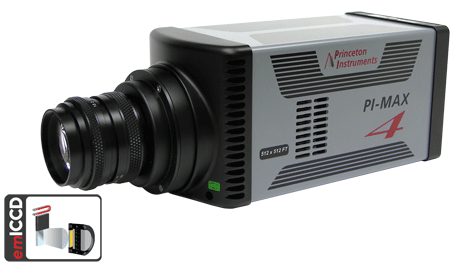 |
Powered by
Princeton Instruments LightField Software
|
|
|
The Ultimate in Precision and Intelligence in an ICCD Camera
-
New! PI-MAX4: 512 EM - World's first emICCD camera delivers single photon sensitivity
-
New! PI-MAX4: 1024f - ICCD with scientific-grade imaging CCD for imaging and spectroscopy applications
-
PI-MAX4 family of cameras - for gating to < 500 picoseconds
-
PI-MAX4 RF for frequency domain imaging applications
|
Model |
Imaging Array |
Pixel Size |
Wavelength |
Peak QE |
512EM
512EMB |
512 x 512 |
16.0 x 16.0 µm |
200 - 900 nm |
>25% Gen II
>50% Gen III filmless
|
|
PI-MAX4: 1024i - digitization up to 32 MHz |
|
Model |
Imaging Array |
Pixel Size |
Wavelength |
Peak QE |
|
1024i |
1024 x 1024 |
12.8 x 12.8 µm |
200 - 900 nm |
>25% Gen II
>50% Gen III filmless
|
|
PI-MAX4: 1024f - digitization up to 10 MHz |
|
Model |
Imaging Array |
Pixel Size |
Wavelength |
Peak QE |
|
1024f |
1024 x 1024 |
12.8 x 12.8 µm |
200 - 900 nm |
>25% Gen II
>50% Gen III filmless
|
PI-MAX4:1024i RF Modulation
|
|
Model* |
Imaging Array |
Pixel Size |
Wavelength |
Peak QE |
|
1024i-RF |
1024 x 1024 |
12.8 x 12.8 µm |
200 - 900 nm |
>25% Gen II
>50% Gen III filmless
|
PI-MAX4: 1024x256 - digitization up to 2 MHz
|
|
Model* |
Imaging Array |
Pixel Size |
Wavelength |
Peak QE |
|
1024x256 |
1024 x 256 |
26 x 26 µm |
200 - 900 nm |
>25% Gen II
>50% Gen III filmless
|
The PI-MAX4 elevates intensified CCD camera technology to the next level. As the newest addition to Princeton Instruments’ acclaimed ICCD camera line, the PI-MAX4 with Gen II or Gen III image intensifier is the result of our numerous years of experience designing gated camera technology informed by unrivaled imaging and spectroscopy application knowledge.
|
Applications for PI-MAX4 cameras include:
-
Frequency Domain / Time Domain Fluorescence lifetime imaging microscopy (FLIM)
-
Time-resolved Imaging & Spectroscopy
-
Plasma Diagnostics
-
Combustion
-
Planar Laser Induced Fluorescence (PLIF)
-
Particle Imaging Velocimetry (PIV)
|
|
Available Formats
The PI-MAX4 family of cameras are available in these formats:
-
512 x 512 - PI-MAX4: 512EM - EM CCD for single-photon sensitivity and best linearity
-
1024 x 1024 - PI-MAX4:1024i - Interline CCD for double image feature
-
1024 x 1024 - PI-MAX4:1024f - Full frame CCD for imaging and spectroscopy
-
1024 x 256 - PI-MAX4:1024x256- for spectroscopy
They boast innovations ranging from precise picosecond gating to intelligent controls, enabling users to set up and execute challenging experiments easily right out of the box.
|

|
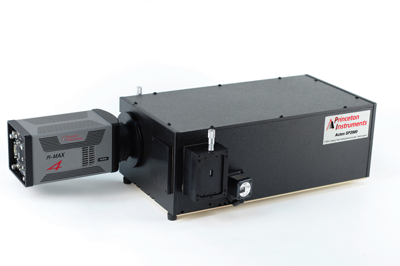
PI-MAX4 with Acton Series Spectrograph
|
Time-Resolved Imaging and Spectroscopy
New PI-MAX4 ICCD cameras offer built-in precision and intelligence to enable advanced research, including the following innovations.
Ultimate in Precision
Superb Linearity
By carefully selecting every single component and painstakingly packaging each of them in a camera that does not require any external electronics boxes except a power supply, Princeton Instruments has ensured that the new PI-MAX4 surpasses the performance of all other scientific ICCD cameras available on the market. The benefits of the PI-MAX4 design are readily apparent in one of the most important camera system specifications: linearity.
Achieve even better linearity with PI-MAX4: 512EM shown in graph below:
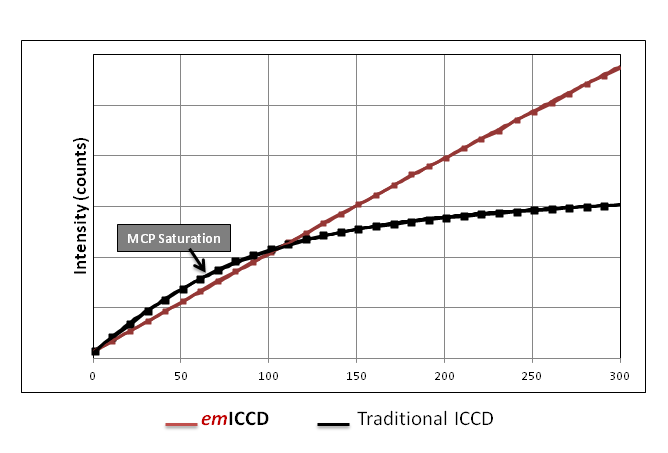
Video Frame Rates and Higher
PI-MAX4: 512EM achieves 32 fps with full 512 x 512 pixel resolution. With custom configurations, hundreds of images and even thousands or spectra per second can be acquired. With dual gain mechanism, this camera can deliver Single-Photon sensitivity.
Download the datasheets for the PI-MAX4: 512EM on the datasheet page
PI-MAX4: 1024i achieves close to video frame rates (even at full 1k x 1k resolution). With ROI and binning, hundreds and even thousands of spectra per second can be acquired while in spectroscopy mode. The new camera also has the ability to capture a gated image or spectrum for every pulse of a high-repetition-rate laser. By contrast, slower-frame-rate ICCD cameras do not allow full synchronization with such pulsed lasers; they use only a fraction of the pulses emitted.
Download the datasheets for the PI-MAX4: 1024i on the datasheet page
PI-MAX4: 1024f has been designed with highest ever speed (10MHz readout) for researchers who want to do imaging and spectroscopy with one ICCD camera.
Download the datasheets for the PI-MAX4: 1024f on the datasheet page
PI-MAX4: 1024x256 has been designed specifically for spectroscopy and offers twice the readout speed of previous-generation ICCD cameras.
Download the datasheets for the PI-MAX4: 1024x256 on the datasheet page

SuperHV
PI-MAX4 cameras boast SuperHV, the latest in high-voltage gating technology, to power the intensifier as well as turn it on and off in response to programmed delays and widths. It is capable of a 1 MHz sustained repetition rate, which is a 20x improvement over previous-generation ICCD cameras.
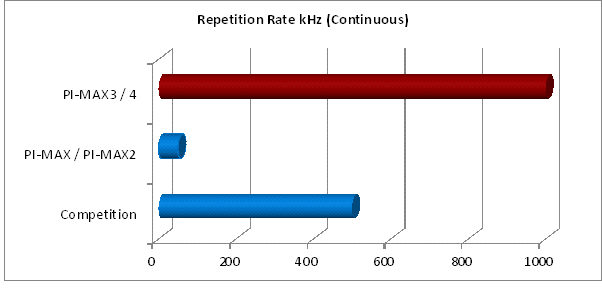
DIF (Double Image Feature):
The PI-MAX4:1024i uses an interline CCD to enable capture of two full-resolution images in quick succession. It quickly transfers a full-resolution image under the interline CCD pixel’s adjacent mask area, enabling the camera to take a second frame in as little as 450 ns (limit imposed by P46 phosphor decay time). The ability to apply the intensifier gate within two frames means lower background even when used with CW laser sources.
Picosecond Gating Technology
PI-MAX4: 512EM(B), PI-MAX4:1024i and PI-MAX4:1024x256 cameras utilize new Princeton Instruments Picosecond gating technology to achieve <500 psec gating, thus delivering exceptionally high temporal resolution for effective background discrimination. And best of all, we achieve this without sacrificing standard intensifiers quantum efficiency!
Ultimate in Intelligence
LightField Software
Princeton Instruments LightField is a new 64-bit data acquisition software platform that has been designed “from the ground up” for scientific imaging and spectroscopy. LightField provides comprehensive control of the PI-MAX4 via easy-to-use tools that help streamline experimental setup, data acquisition, and post processing. LightField is an excellent solution for multi-user facilities.
SuperSynchro Timing Generator
This new precision timing generator built right into the camera head controls intensifier gating, allowing gate widths and delays to be set in 10 psec steps with less than 35 psec rms jitter. It offers a wide variety of options to synchronize the camera with external trigger sources (e.g., pulsed lasers). Now, users can easily set up time-resolved experiments, even ones with complex timing requirements.
SyncMaster:
The PI-MAX4 features a SyncMaster signal output based on the camera’s high-precision internal clock. This signal can be used to continuously trigger pulsed-laser sources. Since the intensifier gating is based on the same clock, the jitter in the whole experiment is kept as low as possible (often only limited by the laser jitter)! In addition, by eliminating the need for external delay generator boxes, valuable lab space is conserved.
|
Advantages with SyncMaster |
|
1. Lowest jitter |
|
2. Eliminate external timing generators |

Princeton Instruments Noise Suppression Technology
Princeton Instruments’ next-generation electronics ensure the best combination of CCD readout speed and lowest possible noise levels in a scientific ICCD camera.
Mounting
Intelligent mount design allows changing C-mount, F-mount and spectroscopy mount quickly and easily in the lab and still stay in focus. Our factory calibrated mounts are designed for precision camera focusing no matter what the application. Furthermore, the flexible optical mount design makes it easy to mount the camera on an English or Metric standard optical table.
Photocathode Cooling
EBI (equivalent background intensity) refers to the thermal emission from photocathode of the intensifier. The PI-MAX4 camera has a provision to cool the photocathode to reduce EBI by as much as 20 times. This is an important consideration for ultra-low light and single photon level measurements.
Gigabit Ethernet (GigE):
This high-bandwidth (125 MB/sec or 1000 Mbps) data interface affords real-time image transmission. The interface supports remote operation from more than 50 meters away.

PI-MAX4 RF for frequency domain imaging applications
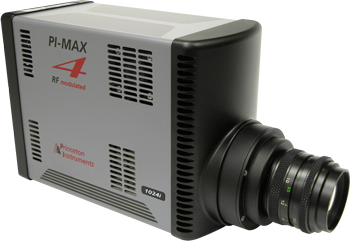
RF Modulation
The PI-MAX4:1024i-RF camera enables frequency domain measurements for fluorescence lifetime studies, in addition to time resolved imaging, with minimal external equipment. By modulating the gain of the Gen III filmless intensifier at a radio frequency (RF) rate, the camera operates as a 2D lock-in amplifier. Each pixel acts as an individual phase-sensitive (lock-in) detector. The PI-MAX4:1024i-RF can be utilized for advanced imaging techniques such as FLIM and FRET.
Download the datasheets for the 1024i-RF on the datasheet page
|

